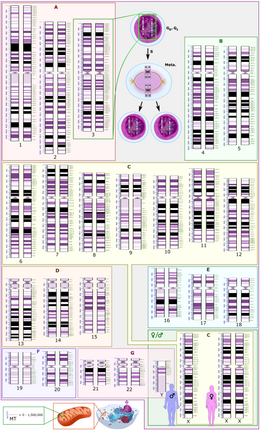
Back صبغي متماثل Arabic Гомологик хромосомалар BA Homologni hromosom BS Cromosoma homòleg Catalan Homologe kromosomer Danish Homologenpaar German Ομόλογα χρωμοσώματα Greek Cromosoma homólogo Spanish Homoloogilised kromosoomid ET Kromosoma homologo EU

A pair of homologous chromosomes, or homologs, is a set of one maternal and one paternal chromosome that pair up with each other inside a cell during fertilization. Homologs have the same genes in the same loci, where they provide points along each chromosome that enable a pair of chromosomes to align correctly with each other before separating during meiosis.[1] This is the basis for Mendelian inheritance, which characterizes inheritance patterns of genetic material from an organism to its offspring parent developmental cell at the given time and area.[2]
- ^ Homologous chromosomes. 2. Philadelphia: Saunders/Elsevier. 2008. pp. 815, 821–822. ISBN 978-1-4160-2255-8. Archived from the original on 2015-11-29. Retrieved 2013-11-01.
- ^ Cite error: The named reference
Griffithswas invoked but never defined (see the help page).